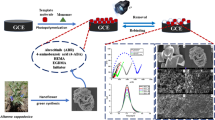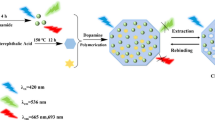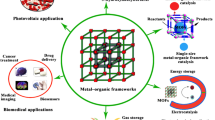Abstract
Temperature-sensitive molecularly imprinted microgels (MIGs) exhibiting esterase activity were prepared by a reverse emulsion method using dialdehyde dextran-histidine conjugate (PAD-His) as the functional macromonomer and p-nitrophenyl phosphate (NPP) as the stable transition state analogue (TSA) as well as Co2+ as the coordination center. The catalytic activity of MIGs was greatly influenced by the amount of the template, and could be modulated by temperature. The hydrolysis kinetics of p-nitrophenyl acetate (NPA) in the presence of MIGs could be described by the Michaelis-Menten equation. The Michaelis-Menten constant and maximum velocity were found to be 2.2 × 10−5 mol/L and 2.04 × 10∞8 mol/h, respectively. In addition, the MIGs were found to have a high catalytic selectivity to NPA.
Similar content being viewed by others
References
Carboni D, Flavin K, Servant A, Gouverneur V, Resmini M. The first example of molecularly imprinted nanogels with aldolase type I activity. Chem Eur J, 2008, 14: 7059–7065
Becker JJ, Gagne MR. Exploiting the synergy between coordination chemistry and molecular imprinting in the quest for new catalysts. Acc Chem Res, 2004, 37: 798–804
Lettau K, Warsinke A, Laschewsky A, Mosbach K, Yilmaz E, Scheller FW. An esterolytic imprinted polymer prepared via a silica-supported transition state analogue. Chem Mater, 2004, 16: 2745–2749
Sellergren B, Karmalkar RN, Shea KJ. Enantioselective ester hydrolysis catalyzed by imprinted polymers. J Org Chem, 2000, 65: 4009–4027
Matsui J, Nicholls IA, Karube I, Mosbach K. Carbon-carbon bond formation using substrate selective catalytic polymers prepared by molecular imprinting: an artificial class II aldolase. J Org Chem, 1996, 61: 5414–5417
Cheng ZY, Zhang LW, Li YZ. Synthesis of an enzyme-like imprinted polymer with the substrate as the template, and its catalytic properties under aqueous conditions. Chem Eur J, 2004, 10: 3555–3561
Tada M, Sasaki T, Iwasawa Y. Design of a novel molecular-imprinted Rh-amine complex on SiO2 and its shape-selective catalysis for α-methylstyrene hydrogenation. J Phys Chem B, 2004, 108: 2918–2930
Liu JQ, Wulff G. Functional mimicry of carboxypeptidase A by a combination of transition state stabilization and a defined orientation of catalytic moieties in molecularly imprinted polymers. J Am Chem Soc, 2008, 130: 8044–8054
Shechter I, Ramon O, Portnaya I, Paz Y, Livney YD. Microcalorimetric study of the effects of a chaotropic salt, KSCN, on the lower critical solution temperature (LCST) of aqueous poly (N-isopropy-lacrylamide) (PNIPA) solutions. Macromolecules, 2009, 43: 480–487
Puoci F, Iemma F, Picci N. Stimuli-responsive molecularly imprinted polymers for drug delivery: a review. Curr Drug Deliver, 2008, 5: 85–96
Huynh DP, Nguyen MK, Kim BS, Lee DS. Molecular design of novel pH/temperature-sensitive hydrogels. Polymer, 2009, 50: 2565–2571
Lee Y, Chung HJ, Yeo S, Ahn CH, Lee H, Messersmith PB, Park TG. Thermo-sensitive, injectable, and tissue adhesive sol-gel transition hyaluronic acid/pluronic composite hydrogels prepared from bio-inspired catechol-thiol reaction. Soft Matter, 2010, 6: 977–983
Park TG. Stabilization of enzyme immobilized in temperature-sensitive hydrogels. Biotechnol Lett, 1993, 15: 57–60
Alexander C, Davidson L, Hayes W. Imprinted polymers: artificial molecular recognition materials with applications in synthesis and catalysis. Tetrahedron, 2003, 59: 2025–2057
Anderson CD, Shea KJ, Rychnovsky SD. Strategies for the generation of molecularly imprinted polymeric nitroxide catalysts. Org Lett, 2005, 7: 4879–4882
Volkmann A, Bruggemann O. Catalysis of an ester hydrolysis applying molecularly imprinted polymer shells based on an immobilized chiral template. Reac & Funct Polym, 2006, 66: 1725–1733
Visnjevski A, Schomacker R, Yilmaz E, Bruggemann O. Catalysis of a Diels-Alder cycloaddition with differently fabricated molecularly imprinted polymers. Catal Commun, 2005, 6: 601–606
Cheng ZY, Li YZ. The role of molecular recognition in regulating the catalytic activity of peroxidase-like polymers imprinted by a reductant substrate. J Mol Catal A: Chem, 2006, 256: 9–15
Svenson J, Zheng N, Nicholls IA. A molecularly imprinted polymer-based synthetic transaminase. J Am Chem Soc, 2004, 126: 8554–8560
Stewart JD, Liotta LJ, Benkovic SJ. Reaction mechanisms displayed by catalytic antibodies. Acc Chem Res, 1993, 26: 396–404
Tong KJ, Xiao S, Li SJ, Wang J. Molecular recognition and catalysis by molecularly imprinted polymer catalysts: thermodynamic and kinetic surveys on the specific behaviors. J Inorg Organomet Polym, 2008, 18: 426–433
Kawanami Y, Yunoki T, Nakamura A, Fujii K, Umano K, Yamauchi H, Masuda K. Imprinted polymer catalysts for the hydrolysis of p-nitrophenyl acetate. J Mol Catal A: Chem, 1999, 145: 107–110
Agarwal A, Gupta U, Asthana A, Jain NK. Dextran conjugated dendritic nanoconstructs as potential vectors for anti-cancer agent. Biomaterials, 2009, 30: 3588–3596
Bruneel D, Schacht E. Chemical modification of pullulan: 1. Periodate oxidation. Polymer, 1993, 34: 2628–2632
Cheung RY, Ying YM, Rauth AM, Marcon N, Wu XY. Biodegradable dextran-based microspheres for delivery of anticancer drug mitomycin C. Biomaterials, 2005, 26: 5375–5385
Brunel F, Veron L, David L, Domard A, Delair T. A novel synthesis of chitosan nanoparticles in reverse emulsion. Langmuir, 2008, 24: 11370–11377
Emgenbroich M, Wulff G. A new enzyme model for enantioselective esterases based on molecularly imprinted polymers. Chem Eur J, 2003, 9: 4106–4117
Say R, Erdem M, Ersoez A, Tuerk H, Denizli A. Biomimetic catalysis of an organophosphate by molecularly surface imprinted polymers. Appl Catal A: Gen, 2005, 286: 221–225
Ma XM, Xi JY, Huang XB, Zhao X, Tang XZ. Novel hydrophobically modified temperature-sensitive microgels with tunable volume-phase transition temperature. Mater Lett, 2004, 58: 3400–3404
Li SJ, Pilla S, Gong SQ. Modulated molecular recognition by a temperature-sensitive molecularly-imprinted polymer. J Polym Sci: Part A, 2009, 47: 2352–2360
Pauling L. Molecular architecture and biological reactions. Chem & Eng News, 1946, 24: 1375–1377
Lerner RA, Benkovic SJ, Schultz PG. At the crossroads of chemistry and immunology: catalytic antibodies. Science, 1991, 252: 659–667
Schultz PG. Antibodies as catalysts. Angew Chem, 1989, 101: 1336–1348
Author information
Authors and Affiliations
Corresponding author
Rights and permissions
About this article
Cite this article
Wang, H., Yang, H. & Zhang, L. Temperature-sensitive molecularly imprinted microgels with esterase activity. Sci. China Chem. 54, 515–520 (2011). https://doi.org/10.1007/s11426-010-4200-z
Received:
Accepted:
Published:
Issue Date:
DOI: https://doi.org/10.1007/s11426-010-4200-z




